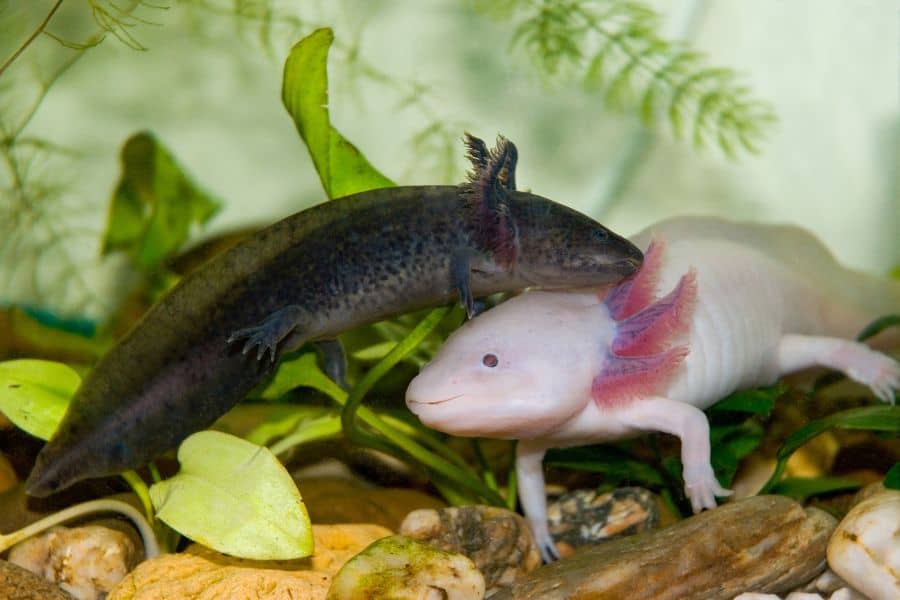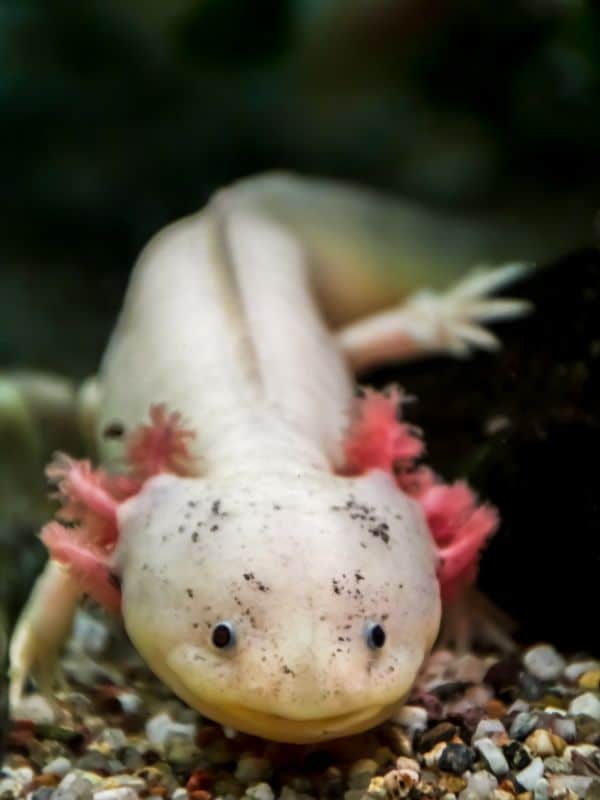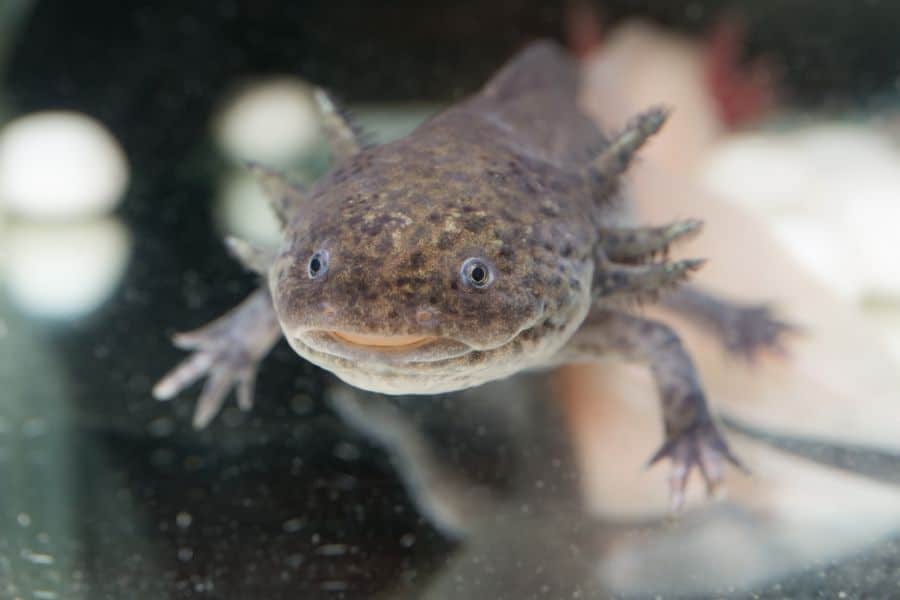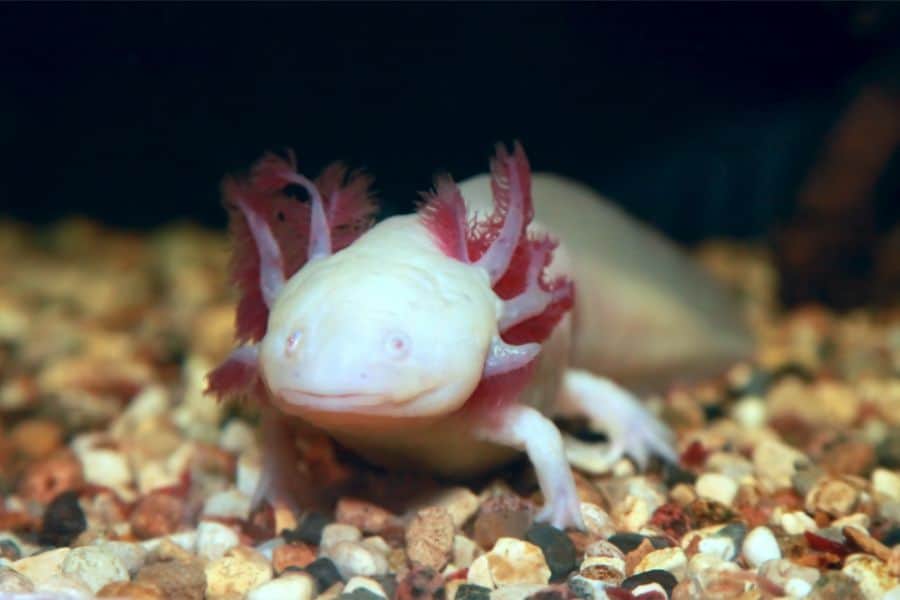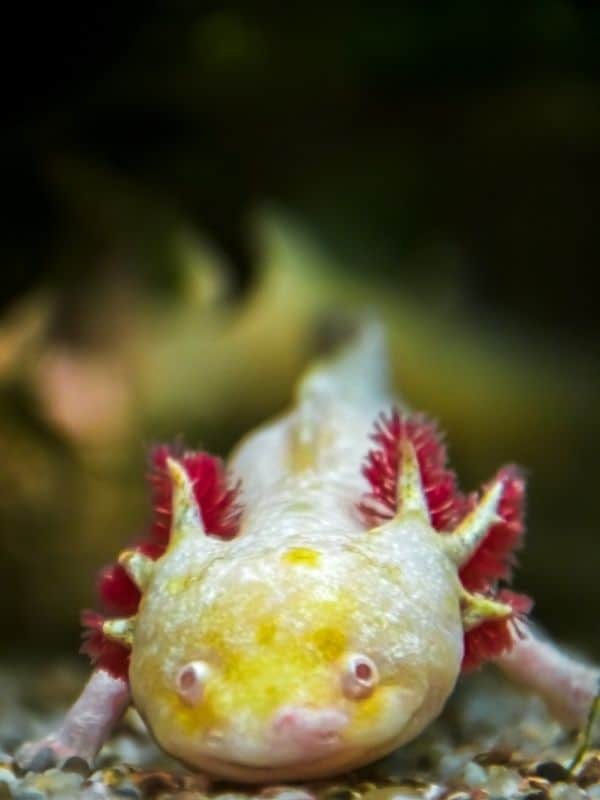Axolotls are quiet little aquatic amphibians that have recently gained popularity among aquarium enthusiasts, and for good reason.
Their exotic appearance, undemanding personality, and innate uniqueness make them pretty great pets.
That said, did you know that there are actuallly plenty of types of axolotls to choose from? They can range from different patterns, and colors–called morphs–and combinations.
In this article, we’ll discuss the most common types of axolotls that you can get today! Without further ado, let’s get to our list.
17 Different Types of Axolotls
Here are the 17 types of axolotls that you may be interested in.
1. Leucistic or White Axolotl
- Main colors: White with dark eyes
- Price range: $100 – $150
- Origin: Captive bred
- Rarity: Common
Quick, think of what an axolotl looks like. Whatever you have in your mind right now, there’s a good chance that it’s a leucistic axolotl, with their iconic “smiling” face.
Leucistic axolotls are a common variety of axolotl, as well as a stable in the hobby. Their most attention-grabbing feature is their white or pale pink skin and pinkish gills, which gives them an ethereal and unique charm – almost like dainty water fairies.
Interestingly, though, even though they’re extremely common in the aquarium hobby, they’re actually incredibly uncommon in the wild. That’s because their coloration would make them stand out and therefore vulnerable to various predators.
Still, if you’re looking for a truly eye-catching feature to your aquatic setups, the leucistic axolotl is an ideal choice. Its color stands out in any tank, making it a fantastic feature and conversation starter.
2. Wild Type Axolotl
- Main colors: Brown, black, and green
- Price: $80 – $100
- Origin: Lake Xochimilco, Mexico
- Rarity: Common
If you’re drawn to nature in its raw for, this type of axolotl is best for you. Known simply as “wild-type axolotl,” it’s a living testament to the natural beauty of these fascinating creatures.
With its earthy brown, black, and green hues, it showcases the classic axolotl appearance as you would see them in their last remaining habitat – at Lake Xochimilco in Mexico. Its exotic, untamed appearance can give anyone a sense of connection to these creatures’ natural habitat.
Unlike with leucistic axolotls, their colors give them an advantage in the often-muddy waters of their home lake. Since the lake is full of organic matter and vegetation, the wild type axolotl’s earthy speckles can do a great job of hiding them from potential predators or letting them stalk their prey.
3. White Albino Axolotl
- Main colors: White, pink, red
- Price: $80 – $100
- Origin: Naturally occurring but multiplied in captivity
- Rarity: Common
The white albino is another mesmerizing axolotl commonly sold in amphibian shops and online. At first glance, it’s easy to mistake this type for the leucistic axolotl, thanks to its pure white skin and reddish or pinkish gills.
But while they may look similar, white albino axolotls feature something that leucistics don’t have: striking red eyes.
Like other albinism mutations in the animal kingdom, white albino axolotls have characteristic red eyes to go with their white skin. They may also display golden flecks on their gill stalks.
One thing you have to keep in mind is that this type of axolotl tends to suffer from the common problems that other albino animals have, such as poor vision and extreme light sensitivity. If you chose to go with this type, make sure their tank has low lighting and plenty of caves to hide in.
4. Golden Albino
- Main colors: Yellow, red
- Price: $80 – $150
- Origin: Captive bred
- Rarity: Common
As its name suggests, the main appeal of the golden albino axolotl type is its yellow coloration and distinctive pinkish-red gills. When they’re young, they look exactly like white albinos but change into their characteristic golden colors when they’re older.
Depending on the individual, these yellow axolotls range from peach to golden yellow and even orange gold. They can also have reflective spots and speckles covering the length of their bodies.
However, like regular albino axolotls, their red or pinkish eyes can also be very sensitive to light. It’s best to give them plenty of hiding spots in your tank so avoid hurting their eyes and stressing them out.
5. Speckled Leucistic
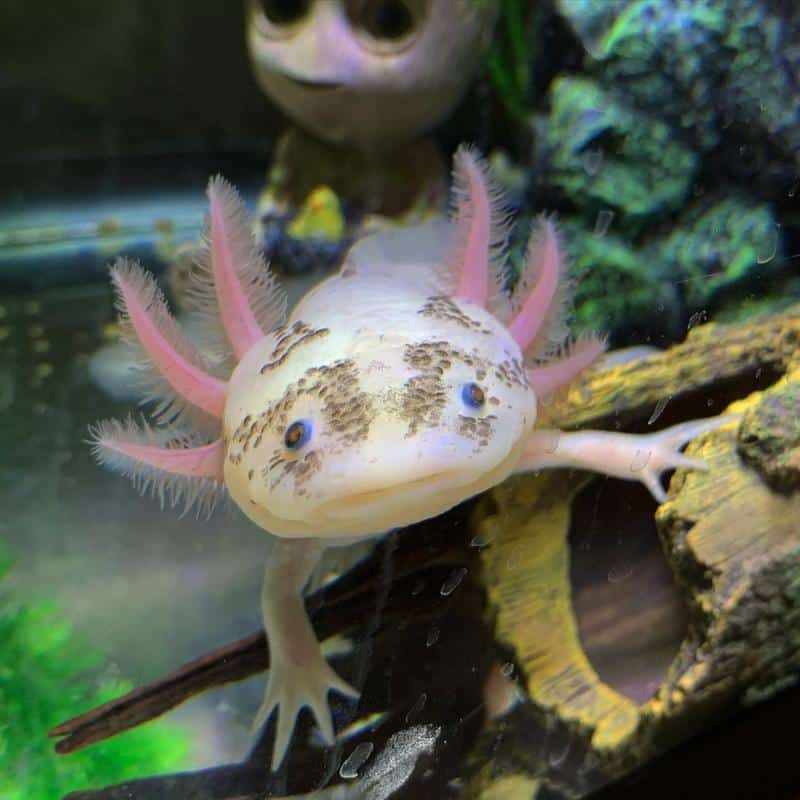
- Main colors: White and pink, with speckles of dark colors
- Price: $80 – $100
- Origin: Captive bred
- Rarity: Common
This color morph combines the elegance of leucistic axolotls with a sprinkle of delicate spots, creating a genuinely enchanting appearance.
They have the same physical characteristics as a leucistic axolotl, save for an interesting spread of brown, black, or dark green speckles on their head area.
However, these speckles aren’t very prominent and may even be hard to spot from afar. Due to this and their relative commonness, they’re not as pricy as other color morphs.
Still, their speckles do bring out an accent of color against the otherwise blank canvas of the white base color, making your pet look like a living masterpiece that brings wonder and fascination to your aquarium tank.
6. Black Melanoid
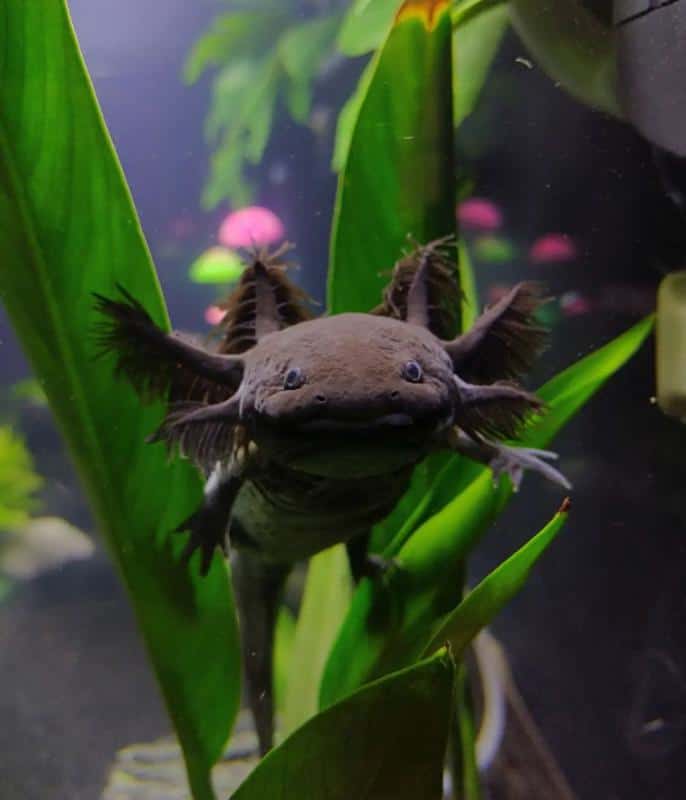
- Main colors: Black
- Price: $80 – $100
- Origin: Captive bred
- Rarity: Common
Also often called the blue axolotl, the black melanoid axolotl is the opposite of the leucistic and white albino types. Compared to other melanoid mutations, they’re relatively common. Still, this doesn’t make them any less special.
Their predominantly black body gives them a more “natural” color. In fact, they’re often mistaken for wild-type axolotls, even though they have a more solid color with fewer speckles and patterns.
Depending on the lighting, they can appear grayish or bluish. And unlike the wild-type axolotl that usually has golden irises, black melanoids have black eyes and gills. Their bellies also tend to be darker.
7. Copper
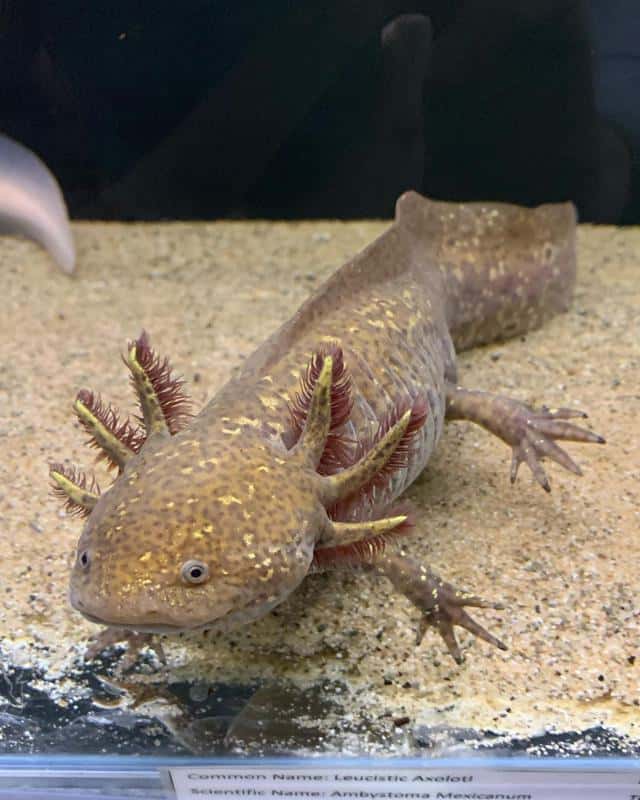
- Main colors: Metallic copper and bronze
- Price: $100 – $200
- Origin: Captive bred from US and Australia
- Rarity: Uncommon
One of the more uncommon types of axolotl is the copper axolotl. This type has warm, metallic copper and bronze hues, adding a touch of elegance to their bodies.
Copper axolotls result from the same mutations as albino axolotls, leaving them with a characteristic lack of pigmentation – except in this case, the yellow pigments are still present.
Copper axolotls will have clear or golden irises in their eyes. They might also have red irises, in which case their albino mutations are stronger, and they’ll be called albino copper axolotls.
This variety will always have speckles of warm sandy colors across their bodies and different shades of gills.
Their copper color makes them look like large metal sculptures that reflect the light and looks right at home in the greenery of a naturalistic tank. Their warm, cute, and elegant image makes them popular in the hobby.
8. GFP Axolotl
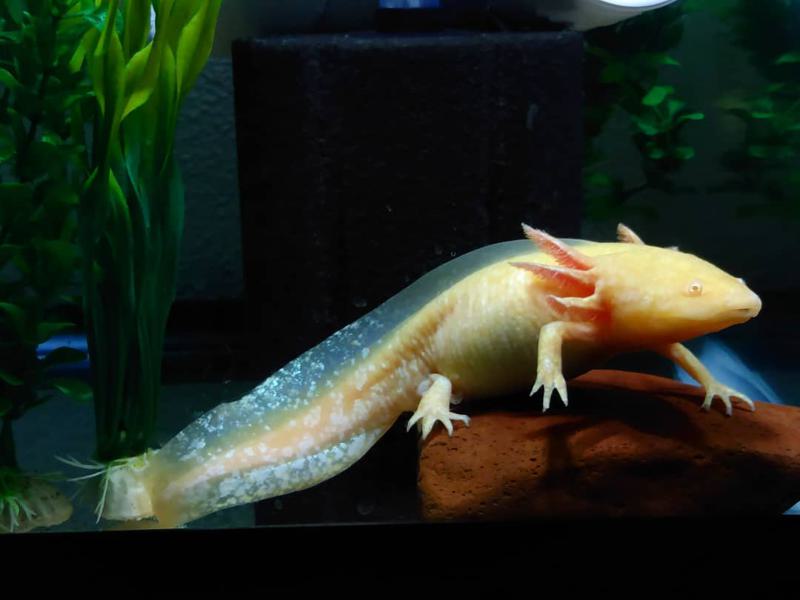
- Main colors: Glow-in-the-dark properties
- Price: $100 – $200
- Origin: Captive bred
- Rarity: Uncommon
GFP stands for “green fluorescent protein.” And true to their name, GFP axolotls have a very interesting characteristic: they glow in the dark, particularly under UV light.
Axolotls with the GFP gene are highly entertaining, especially if you incorporate UV lighting in their tanks. They’re basically the axolotl version of Glo-fish.
That said, the GFP gene can be activated from different types, meaning there can be leucistic, melanoid, and wild-type GFPs. You’ll only know the difference when shined with UV light.
Their unique characteristic makes them stand out as pets, and while they’re not super rare, they can be a bit pricier than other types.
9. Heavily-Marked Melanoid Axolotl
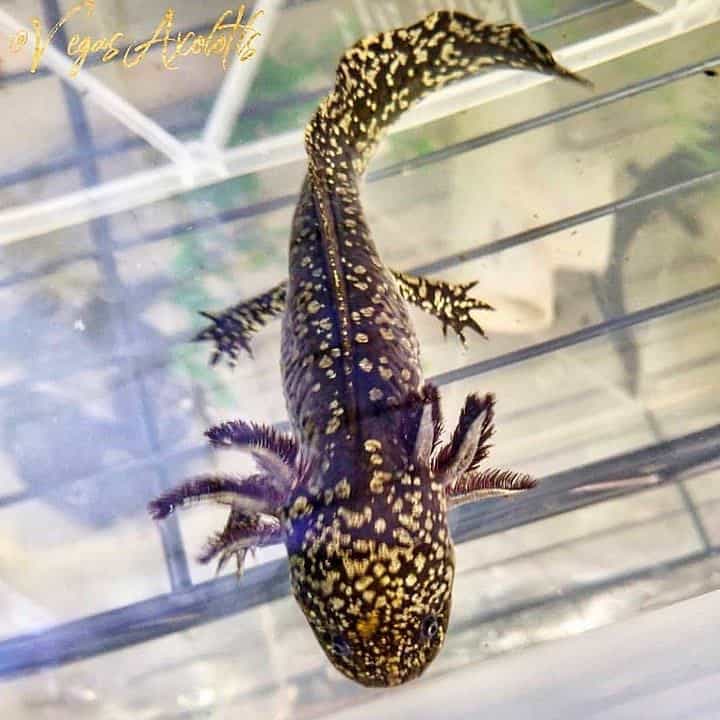
- Main colors: Black with splotches of yellow
- Price: $150 – $250
- Origin: Captive bred
- Rarity: Rare
This variation of the melanoid axolotl is known for its uncommon splotches of color.
While melanoid axolotls are typically almost solid black, the heavily-marked variety goes against that standard by displaying scattered splashes of metallic yellow and other hues. This gives the effect of emphasizing their eye-catching color.
Interestingly, it’s impossible to get a heavily marked melanoid on purpose. There’s no way for even the most experienced breeder to accurately get them in every breeding cycle. Due to this, they’re quite rare and can command some of the highest prices on the market.
10. Firefly Axolotl
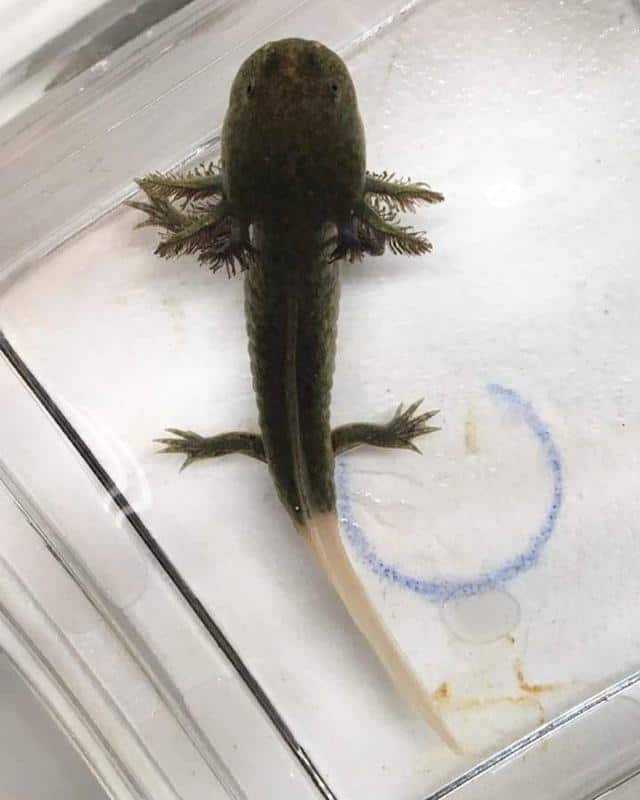
- Main colors: Black and GFP
- Price: $200 – $300
- Origin: Lab-bred
- Rarity: Rare
Firefly morphs are called as such because, like real fireflies, their tails glow in the dark. They typically have the same color morphs as regular GFPs, but only their tails have the actual gene that enable bioluminescence.
One fascinating fact about this morph is that their creator, hobbyist Lloyd Strohl II of Strohl’s Herptiles, never actually meant to create a ‘firefly’ morph. Strohl was simply experimenting with breeding moisaic axolotls – and the rest, as they say, is history.
Currently, there are a few other breeders who have managed to come up with firefly offsprings. They’re priced much higher than other morphs since they’re very hard to get and are considered ultra-rare.
If you’re interested in them yourself, though, keep in mind that there’s a big debate on how ethical it is to keep them in the first place.
11. Axanthic Axolotl
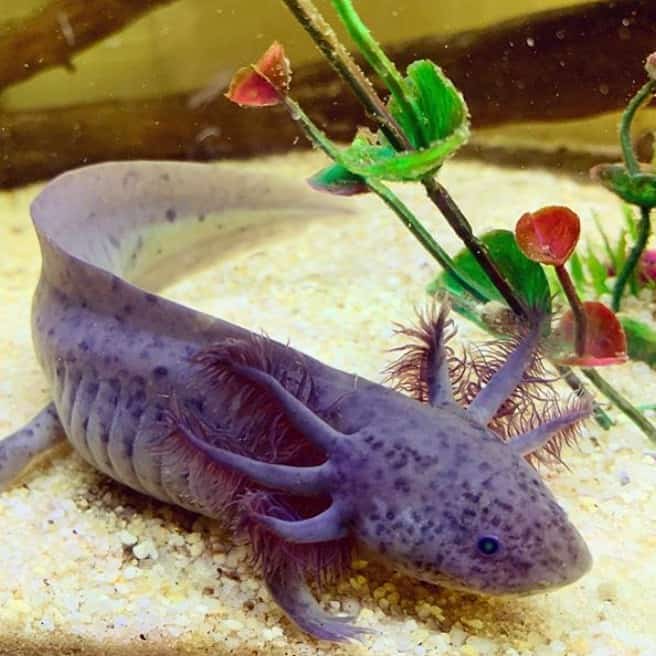
- Main colors: Lack of yellow pigment
- Price: $200 – $300
- Origin: Captive bred
- Rarity: Rare
Axanthic axolotls have no yellow pigments in their bodies, giving them a nice bluish look, whatever their varieties are.
Different types of axanthic axolotls can exist, such as copper, melanoid, and mosaic. There can be many different colors and patterns of this variety, but they will all not have the yellow pigments in their bodies.
This can give rise to many exciting color varieties, with brown to reddish colors and intense gill colors. They can be pricy, though, so they might not be ideal for beginner hobbyists.
12. Mosaic Axolotl
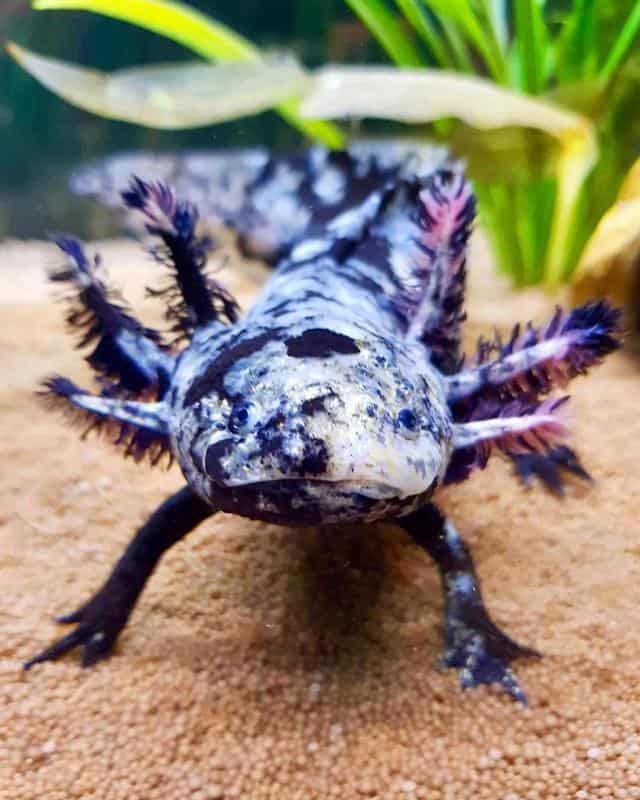
- Main colors: Combination of wild and leucistic
- Price: Not sold
- Origin: Captive or lab bred
- Rarity: Very rare
What do you get when wild and leucistic egg cells combine to form one organism? Well, you’ll get a mosaic axolotl morph – and if that sounds improbable, that’s because it is.
It’s considered quite hard to produce a mosaic axolotl. Technically, they’re anomalies, whcih means each result is unique and exciting. Their never-before-seen patterns will typically have the black, brown, and gold splotches of a wild-type coloration with the white body of a leucistic type.
Just like the heavily-marked melanoid axolotl, though, there’s no way to replicate a mosaic axolotl reliably. Breeders who get them typically keep them as trophies – or sell them to big bidders for extremeley high prices.
13. Piebald Axolotl
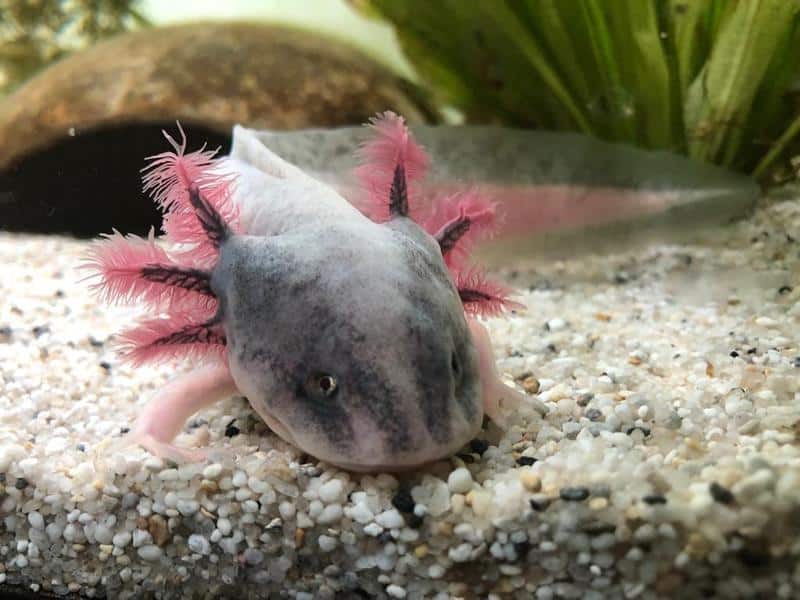
- Main colors: Black against white
- Price: $300 – $500
- Origin: Captive bred
- Rarity: Very rare
If you’re interested in a mosaic axolotl but don’t have the budget for it, you can check out piebald axolotls.
This type of axolotl has splotches of color mostly around their heads, making them look piebald, hence the name. They’re not going to have as definite or clear color groups as mosaic axolotls, but the patches of dark-against-white colors they display throughout their bodies are interesting in their own right.
Their colors might even darken over time, resulting in a lovely black-and-white pattern as they age. Unlike mosaic axolotls, though, breeding them is a bit more predictable, as their coloration is an inherited trait. They’re still pretty rare though, so don’t get your hopes up.
14. Lavender Axolotl
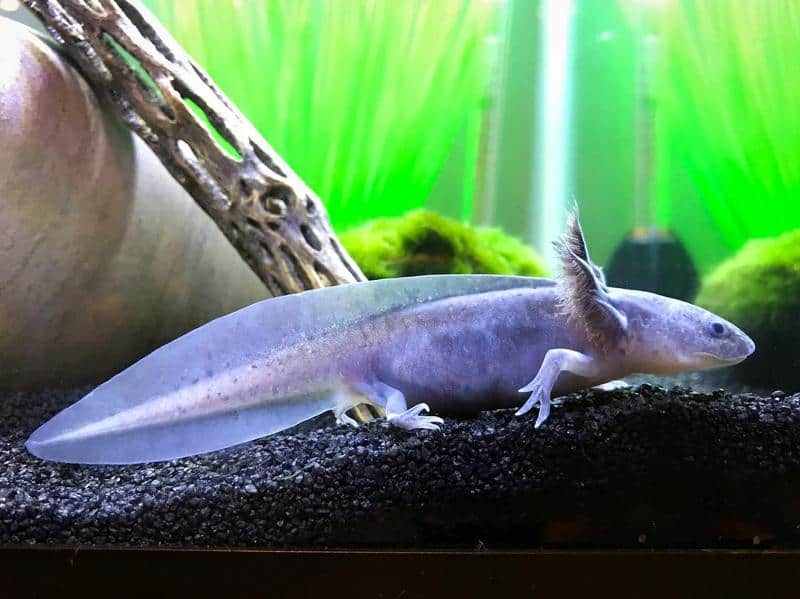
- Main colors: Lavender
- Price: $300 – $500
- Origin: Captive bred in the US
- Rarity: Rare
With their delicate pastel hue, distinctive grayish-red axolotl gills, and black jewel-like eyes, the lavenders are a rare treat for many aspiring axolotl owners.
They’re also called Silver Dalmatians because most lavender axolotls will have gray spots and a slight silvery hue to their bodies. Their skin can go from dark purple to light gray and change color as they age.
You can breed lavender axolotls reliably, but it isn’t easy to get the precise color, even with selective breeding.
15. RLG Axolotl
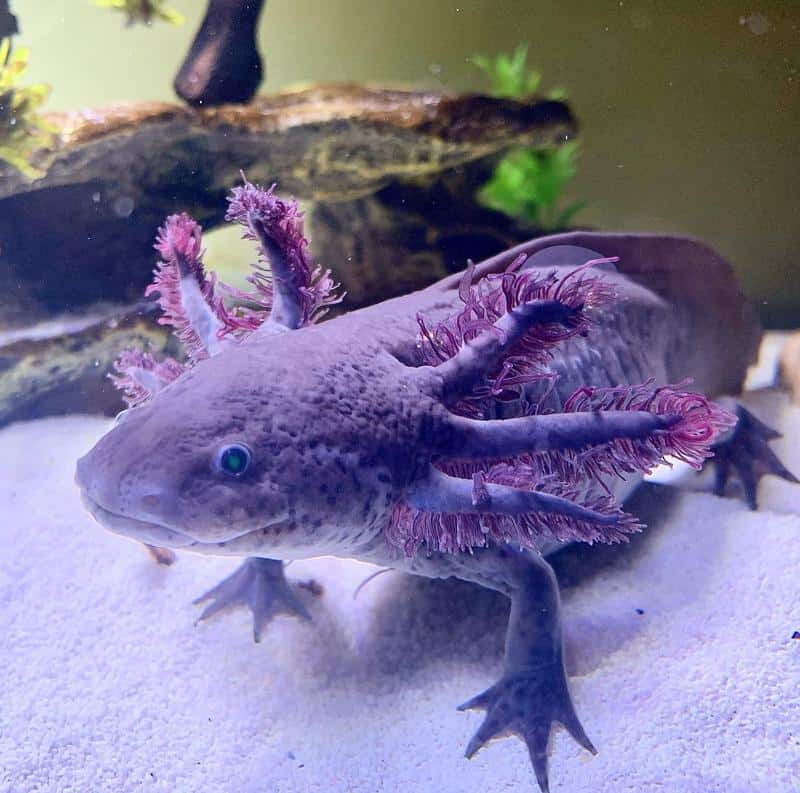
- Main colors: Depending on the type
- Price: $300 – $500
- Origin: Captive bred
- Rarity: Rare
Meet the axolotl with a unique twist – the Really Long Gills (RLG) axolotl. These captivating creatures sport exceptionally elongated gills that make them stand out among other types. Adult axolotls of this variety often have gills that reach up to 2 inches long.
Since the RLG morph isn’t color-based, you can have many different types with an RLG morph. You can get leucistic, wild types, copper, and more, depending on what types the particular morph occurs during breeding.
Since it can be difficult to breed for the RLG trait, axolotls that sport this captivating and elegant morph are considered rare and fetch hundreds of dollars in a exceedingly high-demand market.
16. Chimera Axolotl
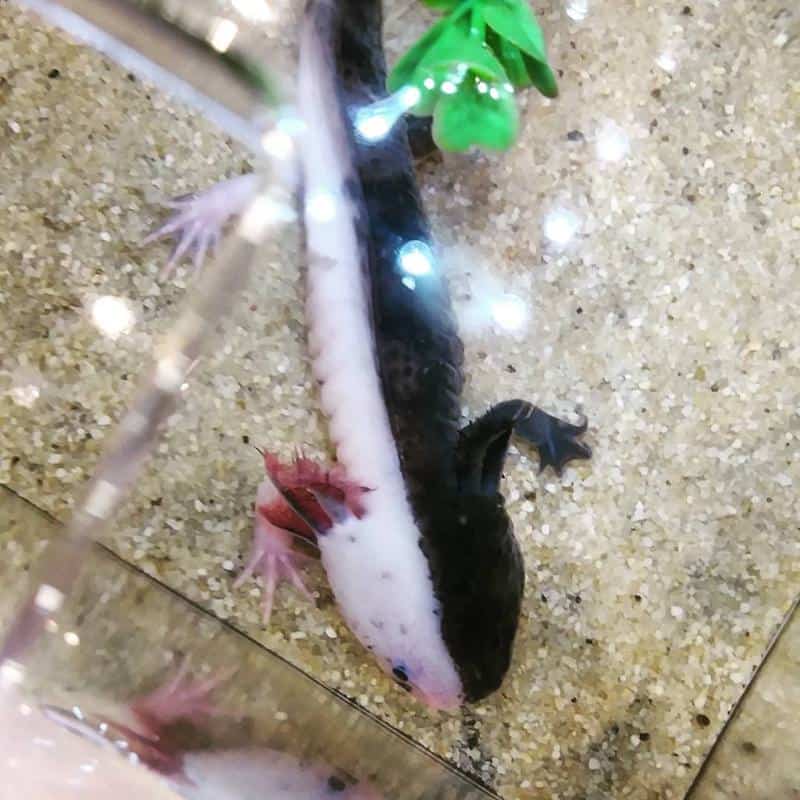
- Main colors: Depending on the type
- Price: Not for sale
- Origin: Captive bred
- Rarity: Very rare
The chimera axolotl is so rare that some enthusiasts don’t even consider them a true morph.
This particular chimera type happens like the mosaic axolotl. Before birth, two eggs with completely different traits fuse, but instead of growing into one individual, some parts of their respective types show through.
As a result, the chimera axolotl looks like it’s split down the middle. One side will display one type, while the other will display another. Typically though, chimeras will have one side of them a black melanoid type, with the other side leucistic type – a rare axolotl black and white color.
Keep in mind that there are only a handful of chimera axolotls around the world. Aside from the difficulty of coming up with this offspring, many chimera axolotls don’t grow into adulthood. And if they do happen to grow, they tend to suffer many health problems, leading to a shortened life span.
This is why they’re often not for sale and are instead kept by labs or some very lucky breeders.
17. Enigma
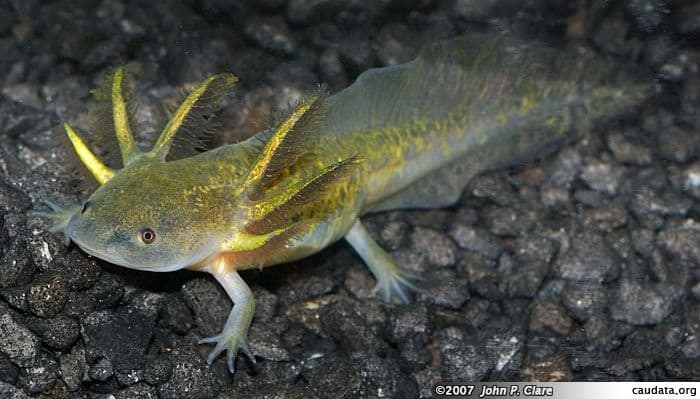
- Main colors: Changing color
- Price: Not for sale
- Origin: Captive bred
- Rarity: Very rare
If you think the chimera morph is rare, the enigma is even more so. In fact, there’s only one recorded enigma morph today.
True to its name, very little is known about the enigma axolotl, save that it’s unique. Baby enigmas are typically almost all black, shifting to a yellow and green coloration as they enter their juvenile stage. Once they become adults, they’ll have a dark gray color on top with a very light belly.
While the hobbyist axolotl world can’t hope to own this mysterious axolotl type today, we’re sure that someone someday will uncover the secret, and there’ll be more of it around.
Also Read:
FAQs
Why Do Axolotls Have Different Colors?
The most popular axolotl gene and color varieties are the results of selective breeding – and sometimes even laboratory experiments.
Axolotls are easy to breed and have many intriguing physical characteristics, so plenty of people are working to breed them and study their secrets.
Are Axolotls Rare?
Like other kinds of animals, axolotls have many different varieties. While some of them can be extremely rare and pricy (and sometimes even not for sale), plenty of others are common enough to be available in the nearest aquatics shop.
Are Axolotls and Mudpuppies the Same?
While the two species look very similar, axolotls and mudpuppies aren’t the same. Axolotls are neotenic reptiles native to Mexico, while mudpuppies are native to North America.
Final Thoughts
The wonders that axolotl different colors bring to the aquarist hobby are immeasurable. There are tons of axolotl colors around, are more yet to be studied and discovered, like the enigma axolotl.
While beginners might find the sheer variety overwhelming, this article helps you better look at the kind of axolotl you want to keep.
Whether you’re looking for basic axolotl morphs to impress your friends or rare ones to impress the axolotl community around you, you now have everything you need to get started in this article. All that’s left is to make the decision and your new pet!
